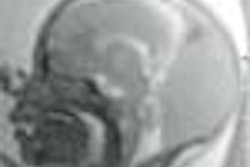SAN FRANCISCO - The anatomic mechanisms of upper airway obstruction have been obscured by the difficulty of differentiating lymphoid tissue, such as tonsils and adenoids, from surrounding soft-tissue structures. This information is particularly important when treating children with sleep-disordered breathing, and MRI could solve the problem, according to a presentation at the American Thoracic Society (ATS) conference on Monday.
Children who have undergone adenotonsillectomy can suffer from sleep-related breathing disorders for two reasons: either the surgery has left behind remnants of the adenotonsillar, or the natural craniofacial structure is to blame, explained Dr. Lynn D’Andrea from the department of pediatrics at the University of Virginia Health System in Charlottesville.
"A lot of people believe that the most common cause of sleep apnea in children is big tonsils and big adenoids," D’Andrea told AuntMinnie.com. "But that struck us as a simplistic explanation. We wanted to see if we could assess anatomy with MRI." Currently, there is no standard imaging protocol for assessing these patients. The lack of radiation made MRI preferable over CT or x-ray, she added.
D’Andrea and her co-authors, Dr. Spenser Gay from the department of radiology and Dr. Paul Suratt from the department of internal medicine, studied 13 children ages 6-12 before and after adenotonsillectomy. The majority had both tonsils intact, although in one case, the patient had only a left tonsil because the right had been removed at an earlier time. Sleep-disordered breathing symptoms included snoring, labored breathing, or obstructed pauses in breathing.
Patients were imaged on a Magnetom Vision 1.5-tesla MR unit with a head coil (Siemens Medical Solutions, Iselin, NJ). The patient was placed in a supine position with the head in a neutral position. Upper airway anatomy was assessed using T1-weighted, turbo spin-echo (TSE), fat-saturation pulse sequences. Axial sections were obtained from hard palate to larynx. Sagittal sections were obtained from the midline through the airway in each lateral direction. The repetition time was 4,505 msec, the echo time was 99 msec, and the slice thickness was 4 mm.
Neither a contrast agent nor a sedative was used. The 12-15 minute image acquisition time was well-tolerated by the children, D’Andrea said.
Prior to surgery, the children had well circumscribed, round, white structures with increased signal intensity in the tonsillar fossa. Similar tissue was seen in the nasopharyngeal region. In a patient with only one tonsil, a well-circumscribed, round, white tissue mass in the left tonsillar fossa was seen on the MR scan. Following adenotonsillectomy and imaging, these structures were absent.
"[MRI] will allow precise measurement of adenotonsillar tissue that can otherwise be done only after it has been removed, and detection of adenotonsillar remnants that have not been completely removed by surgery. This has important implications for research projects involving children with sleep-disordered breathing," the authors concluded in the poster.
D’Andrea said the group is looking to enroll 200 children in a larger study (they currently have 180) who will be assessed using MRI before and after tonsil surgery. In addition to studying the anatomy with imaging, neurocognitive and sleep studies will be administered.
Between 2% and 4% of children in the U.S. are affected by sleep apnea, D’Andrea said. While that figure may not seem significant, some of the symptoms of sleep apnea could be confused with attention deficit/hyperactivity disorder (ADHD).
"Kids with sleep apnea can get irritable and hyper," she said. "So there’s a good chance that some of these kids are being misdiagnosed with ADHD and being medicated incorrectly."
In another ATS presentation, researchers from Boston examined the correlation between sleep-disordered breathing and ADHD based on a questionnaire completed by parents. They found parent-reported trouble breathing during sleep -- and a daytime sleepiness of more than one night a week -- was associated with problem behaviors such as restlessness, hyperactivity, and aggression.
By Shalmali PalAuntMinnie.com staff writer
May 22, 2001
Click here to post your comments about this story. Please include the headline of the article in your message.
Copyright © 2001 AuntMinnie.com



















